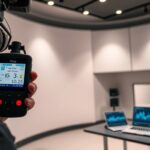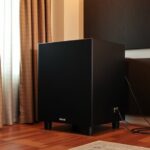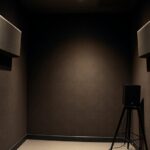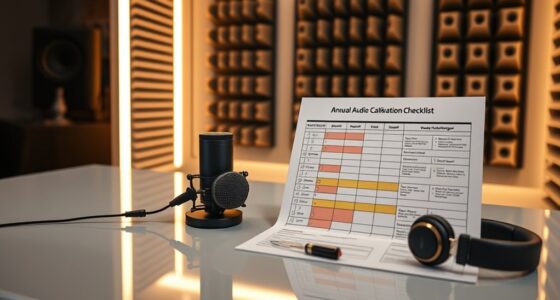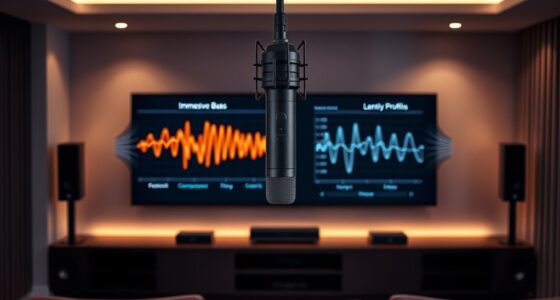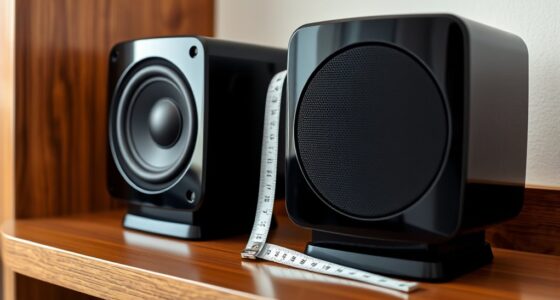To correct bass nulls without moving walls, start by identifying the problem spots with a measurement microphone and software. Use targeted EQ to boost the frequencies where dips occur, and add bass traps or acoustic panels at key reflection points to absorb problematic resonances. Adjust your subwoofer placement and listening position to minimize cancellations. Employ room correction tools for precise fine-tuning. Keep experimenting with these techniques to improve your sound—more detailed strategies await if you continue.
Key Takeaways
- Use subwoofer placement adjustments, moving the sub slightly to find positions that minimize nulls.
- Apply targeted room EQ and calibration with measurement microphones to compensate for bass dips.
- Incorporate bass traps and acoustic treatments at reflection points and corners to absorb problematic frequencies.
- Experiment with speaker and listening positions to reduce nulls without wall modifications.
- Use digital signal processing and room correction software to flatten bass response and fill in dips.
Identifying and Confirming Bass Nulls in Your Room

To effectively address bass nulls, you first need to identify where they occur in your room. Start with bass frequency analysis using a reliable measurement microphone and software. Play test tones or a frequency sweep and observe the response to detect dips in bass levels. Null detection techniques involve moving your microphone around the listening area to pinpoint where bass frequencies weaken or cancel out. By systematically testing different locations, you’ll notice consistent low points indicating null zones. Confirm your findings by comparing multiple measurements and listening for noticeable bass dips. This process helps you accurately locate nulls, giving you a clear understanding of where problematic frequencies occur. Incorporating room acoustics principles can further enhance your ability to identify and address these nulls effectively. Understanding frequency response is crucial for interpreting measurement data and making informed adjustments. Recognizing the behavior of standing waves is also essential, as they contribute significantly to null formation in enclosed spaces. Identifying these areas is essential before implementing any corrective measures, and applying room treatment strategies can help mitigate the impact of standing waves and nulls. Additionally, considering speaker placement can play a vital role in minimizing nulls and optimizing bass response throughout the listening area.
Using Equalization to Fill in Bass Dips

Once you’ve identified where the bass dips occur, you can use equalization to boost those specific frequencies. Applying targeted EQ boosts helps fill in the gaps without affecting the overall sound balance. Just make sure to listen carefully and adjust to achieve a natural, even bass response. Using precise sound frequency adjustments can further enhance the clarity and fullness of your bass. Incorporating audio calibration techniques can also improve your overall sound quality. Additionally, understanding how tuning methods influence sound distribution can help optimize your setup effectively. Monitoring retail hours can ensure your equipment and supplies are available when needed for adjustments. Exploring data management concepts from blockchain technology can provide innovative approaches to organizing and analyzing your sound data for better results.
Identifying Bass Dips
Because bass dips can be subtle and difficult to detect by ear alone, it’s essential to utilize precise listening techniques and visual tools like spectrum analyzers. Start with proper subwoofer calibration to ensure your system’s baseline is accurate. Use speaker isolation to eliminate external noises that may mask dips. Play test tones or bass-rich music and observe the analyzer for drops in the frequency response. Focus on identifying consistent weak points rather than momentary fluctuations. Comparing multiple listening positions can reveal if dips are location-specific. Once identified, note the frequencies where dips occur. This careful process helps you accurately pinpoint problem areas, setting the stage for effective equalization to fill in the bass dips. Additionally, understanding how AI integration enhances audio processing can assist in optimizing your system for more precise correction. Employing tuning techniques that incorporate digital tools can further refine your ability to correct these nulls effectively. Incorporating GMC tuning methods can also provide insights into advanced audio calibration for more tailored sound adjustments. Recognizing the importance of digital signal processing allows for more accurate and adaptive correction during the tuning process. Furthermore, leveraging room acoustic analysis can help identify how your space influences bass nulls and guide targeted improvements.
Applying Targeted EQ Boosts
Applying targeted EQ boosts is an effective way to address bass dips once you’ve identified their frequencies. Your room dimensions can influence where these nulls occur, so focus on boosting specific bass frequencies where dips are prominent. Adjusting the speaker height might also help, as it changes the interaction between your speakers and room modes. Use a parametric EQ to carefully increase gain at the problematic frequencies, but avoid overdoing it to prevent muddiness or other imbalances. Starting with small boosts and listening critically ensures the sound remains natural. Remember, the goal is to fill in the dips without creating new issues. Precise, minimal adjustments tailored to your room’s unique characteristics will produce the best results. Incorporating room acoustics considerations can further enhance your ability to correct bass nulls effectively, especially when understanding how modal behavior impacts sound distribution. Paying attention to speaker placement can also significantly influence the effectiveness of your EQ adjustments, leading to more balanced bass response. Additionally, understanding sound wave interference can help you anticipate how different frequencies combine and cancel out, aiding in more precise corrective measures. Being aware of Gold IRA strategies may not directly relate to acoustics, but it highlights the importance of well-informed decisions in complex areas.
Balancing Overall Sound
After making targeted EQ boosts to address specific bass dips, it’s important to contemplate how these adjustments influence the overall sound. Proper subwoofer calibration ensures your bass response remains balanced, preventing overemphasis or thinness. Additionally, speaker phase adjustment helps align your speakers and subwoofer, filling in dips and smoothing out frequency response. To effectively balance overall sound:
- Reassess your subwoofer calibration, ensuring levels and crossover points suit your room.
- Fine-tune speaker phase to align sound waves and eliminate phase cancellation issues.
- Use equalization subtly to fill in bass dips without causing muddiness or distortion.
- Incorporating wheatgrass into your audio setup may sound unconventional, but understanding how different elements interact can help optimize your sound environment.
- Regularly monitor your sound setup with room acoustics considerations to maintain a balanced and immersive listening experience, and consider experimenting with fabric decorating markers to customize speaker covers for aesthetic enhancement.
Implementing Bass Traps and Acoustic Treatments

To effectively reduce bass nulls, you need to focus on strategic placement of bass traps and acoustic treatments. Choosing the right materials and optimizing your room’s shape can make a significant difference. These techniques help create a balanced sound environment where bass frequencies are better controlled.
Strategic Placement Techniques
Strategic placement of bass traps and acoustic treatments is essential for effectively reducing bass nulls in your listening space. Proper positioning targets areas where bass resonance builds, helping to balance sound and improve speaker calibration. To optimize placement:
- Position traps at room corners, where bass energy accumulates, to dampen nulls caused by standing waves.
- Place acoustic panels at primary reflection points, minimizing bass resonance that interferes with clarity.
- Experiment with speaker and listener placement, moving speakers slightly to find spots that minimize nulls without moving walls.
Effective Material Selection
Choosing the right materials for bass traps and acoustic treatments makes a significant difference in controlling low-frequency nulls. You need materials that excel at resonance control, absorbing problematic frequencies without adding unwanted color to your sound. Rigid and porous materials like mineral wool, fiberglass, or acoustic foam are ideal, as they effectively dampen bass resonances. Durability is also vital—select materials that won’t degrade over time or with exposure to humidity, ensuring long-lasting performance. Proper material selection helps prevent unwanted sound reflections and reduces the chance of secondary resonances that can worsen nulls. By focusing on resonance control and material durability, you create a stable environment with consistent bass response, making your acoustic treatments more effective and reliable over the long term.
Room Shape Optimization
Optimizing your room shape is essential for effectively implementing bass traps and acoustic treatments. A well-designed shape minimizes wall resonance and improves subwoofer calibration, reducing bass nulls. Start by analyzing the room’s dimensions and symmetry to avoid standing waves. Consider the following:
- Rearrange furniture and equipment to break up parallel surfaces, reducing wall resonance.
- Use asymmetric wall angles or irregular shapes to disperse bass waves.
- Place bass traps in corners and along reflective surfaces to target problem areas.
These adjustments help control low-frequency behavior, making subwoofer calibration more accurate. Proper room shape ensures bass traps work efficiently, preventing nulls and improving overall sound clarity. Small changes in shape can considerably enhance your room’s acoustic response, resulting in more balanced, tight bass.
Adjusting Subwoofer Placement for Better Response
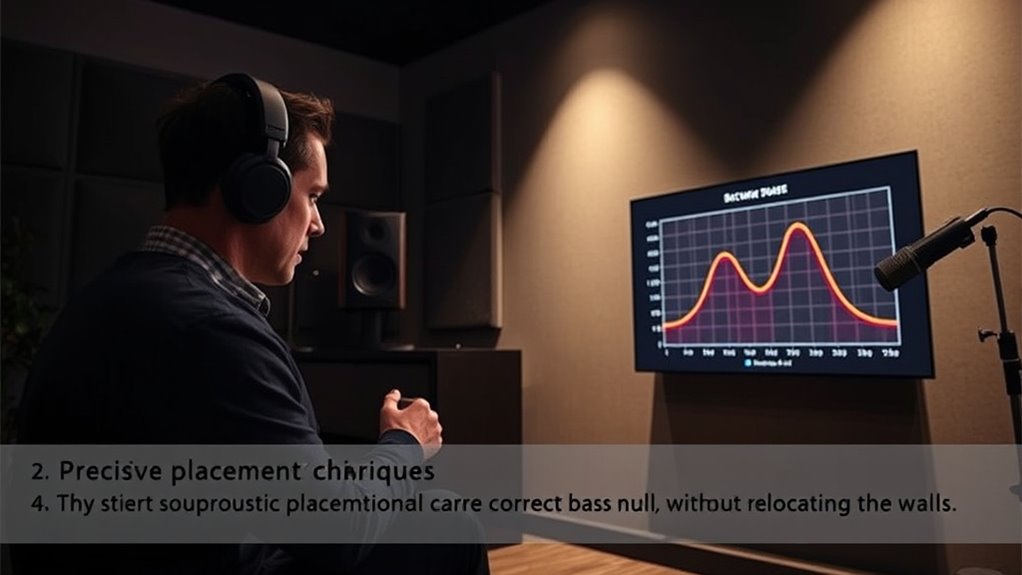
To improve your subwoofer’s response and reduce bass nulls, start by experimenting with its placement in the room. Moving the subwoofer slightly can substantially impact bass frequency tuning, helping you find spots where nulls are minimized. Focus on positions that enhance subwoofer isolation from room boundaries and furniture, which can cause phase cancellations. Avoid placing the sub too close to walls or corners initially, as these can create strong nulls. Instead, try moving it around the room while listening for smoother, more balanced bass. Use your ears to identify where the bass sounds fuller and less hollow. Small adjustments can make a big difference, so take your time to find the most effective spot that delivers consistent, rich bass response without unwanted nulls.
Employing Room Correction Software and Measurement Tools
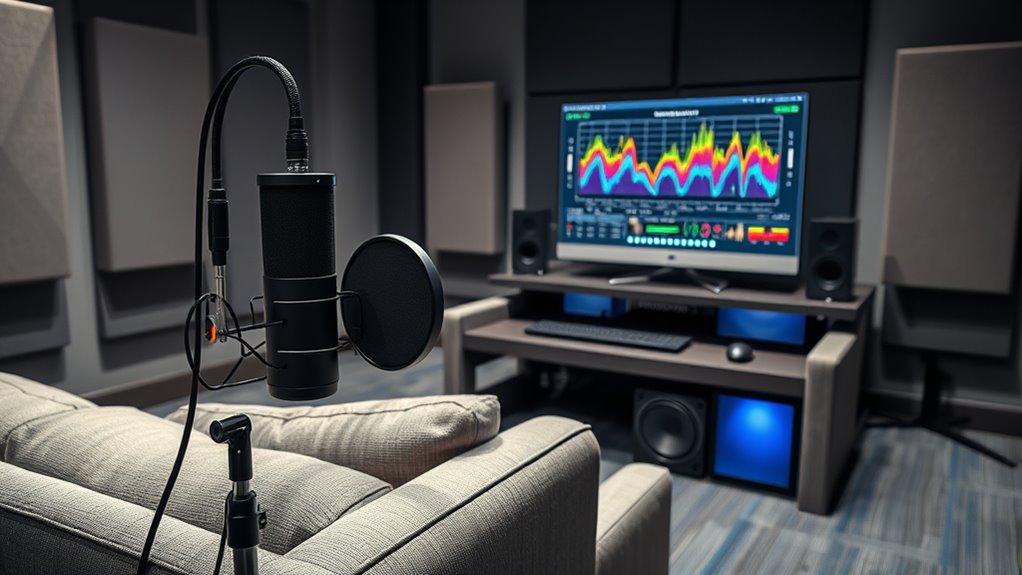
Employing room correction software and measurement tools can substantially enhance your subwoofer’s performance by providing precise, data-driven adjustments. By analyzing room dimensions and speaker calibration, you can identify problem areas like bass nulls. Using a microphone and measurement software, you can capture frequency response data and pinpoint issues causing bass dips. Then, the software can automatically or manually adjust EQ settings to compensate for room-induced anomalies.
Here are key steps:
- Measure your room with a calibrated microphone to identify nulls and peaks.
- Use correction software to analyze data and generate tailored EQ filters.
- Apply these filters to your system, ensuring smoother bass response and better integration.
Optimizing Listening Position and Speaker Arrangement
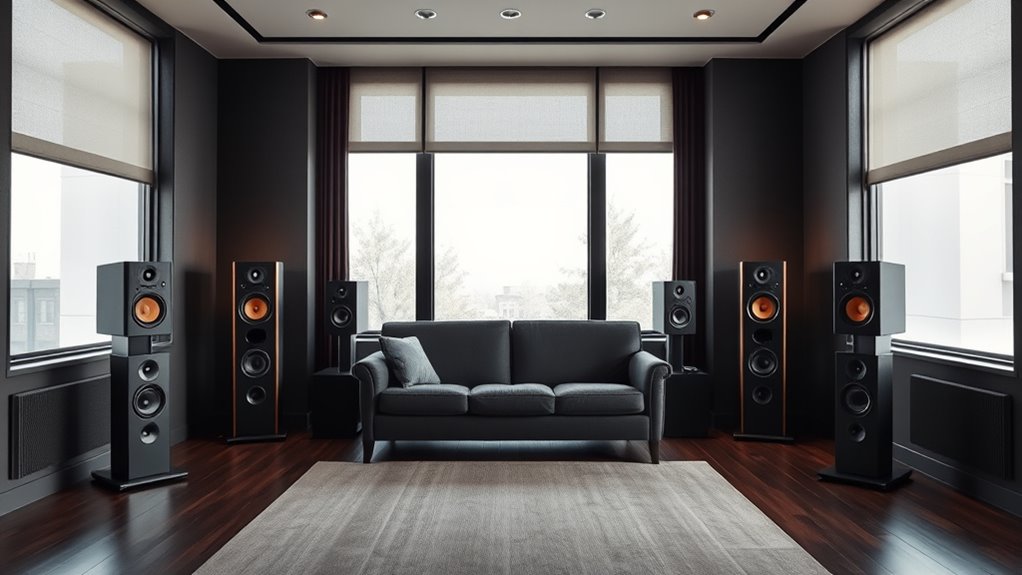
Adjusting your listening position and speaker placement can dramatically improve bass response and overall sound quality. Use visualization techniques to picture your room’s acoustics and identify ideal spots. Experiment with listener position adjustment by moving slightly forward, back, or to the sides to find the sweet spot where nulls diminish. Proper speaker arrangement guarantees even sound distribution and minimizes reflections. Here’s a simple guide:
| Tip | Effect |
|---|---|
| Move seats slightly | Reduces nulls, improves clarity |
| Adjust speaker angles | Enhances direct sound |
| Experiment with distance | Balances bass and mids |
Frequently Asked Questions
Can Bass Nulls Be Completely Eliminated Without Acoustic Treatment?
You wonder if you can eliminate bass nulls without acoustic treatment. While full elimination is tough, you can improve the situation by adjusting room geometry and speaker positioning. Moving your speakers or listening position slightly can reduce nulls caused by destructive interference. Experimenting with angles, distances, and placement helps, but for a complete fix, some acoustic treatment might still be necessary to fine-tune bass response effectively.
Are There Specific Room Shapes That Naturally Reduce Bass Nulls?
Did you know that room shape markedly impacts null reduction? Certain shapes, like rectangular or asymmetrical designs, naturally minimize bass nulls by dispersing sound waves more evenly. When considering room shape, you can reduce nulls without extensive acoustic treatment. You’ll find that optimizing your space’s shape can be a practical, effective way to improve bass response, helping you achieve clearer, more balanced sound without costly modifications.
How Does Furniture Placement Affect Bass Nulls?
Furniture arrangement plays a key role in affecting bass nulls, as it can help break up sound waves and reduce standing waves. By strategically placing large pieces, you can diffuse sound and minimize null points. Wall positioning also matters; adding furniture near walls can alter reflections and improve bass response. Experiment with different arrangements to see how they influence bass nulls, making your sound more balanced without needing to move walls.
Can Multiple Subwoofers Improve Bass Response Without Wall Movement?
Think of your room as a symphony, where each note needs perfect placement to shine. Using multiple subwoofers can be like adding more instruments, filling in the gaps. By tweaking speaker placement and subwoofer positioning, you can smooth out bass nulls and create a richer, more balanced sound. This approach lets you fine-tune your bass response without moving walls, turning your space into a concert hall.
What Are the Best Portable Solutions for Correcting Bass Nulls?
For correcting bass nulls, portable solutions like compact subwoofers are your best bet. They’re easy to move around, letting you optimize your sound field correction without rearranging your space. Look for models with adjustable phase and crossover controls, so you can fine-tune the bass response on the fly. These portable subwoofers give you flexible, high-quality sound adjustments, ensuring you achieve a balanced and immersive audio experience wherever you set them up.
Conclusion
By understanding and addressing bass nulls, you can substantially improve your room’s sound quality without moving walls. Did you know that proper placement and treatment can boost bass response by up to 50%? Using measurement tools, EQ, and acoustic treatments, you’ll create a balanced, immersive listening experience. Take the time to analyze your space, and you’ll enjoy richer, fuller bass—transforming your room into a true audiophile haven.





